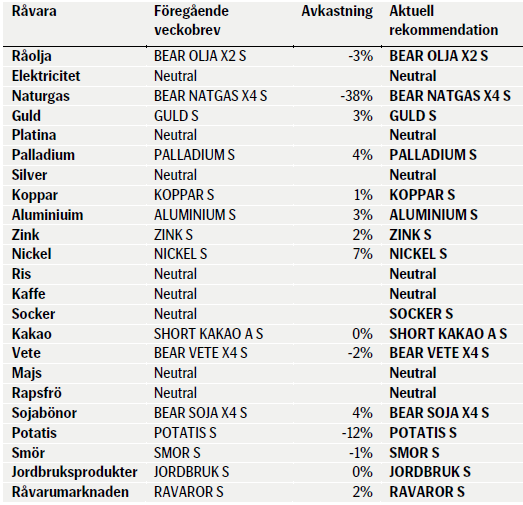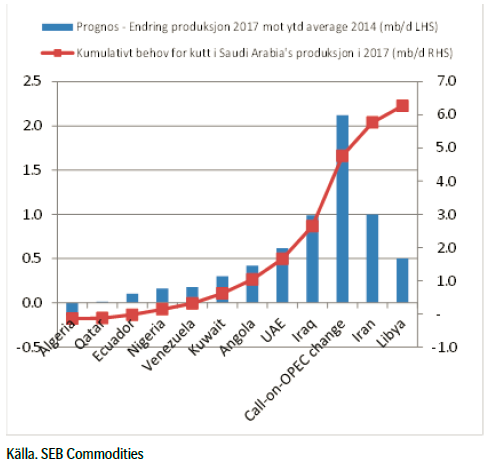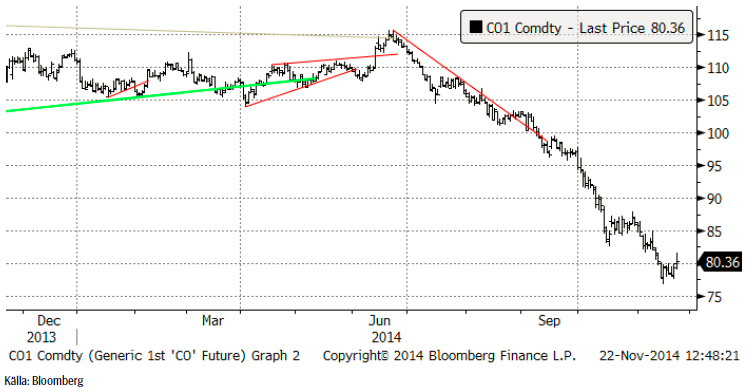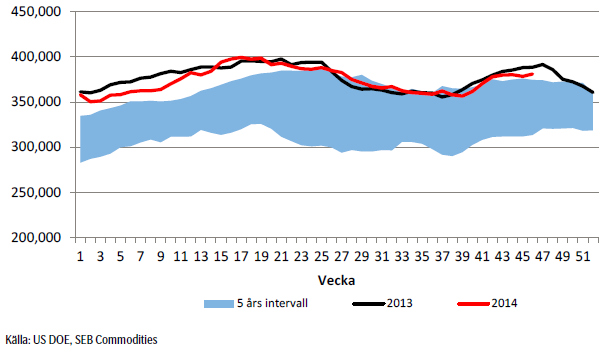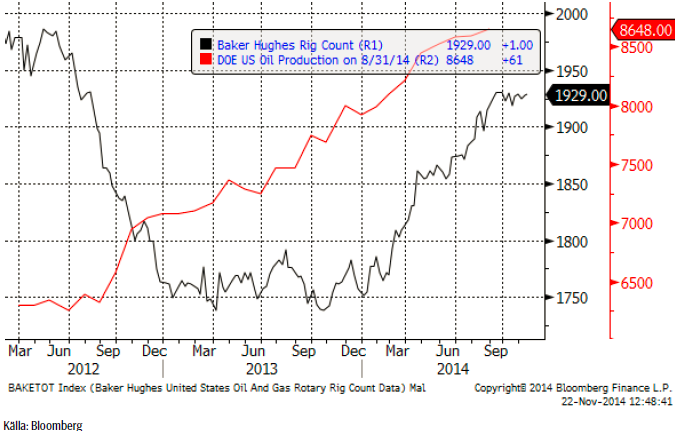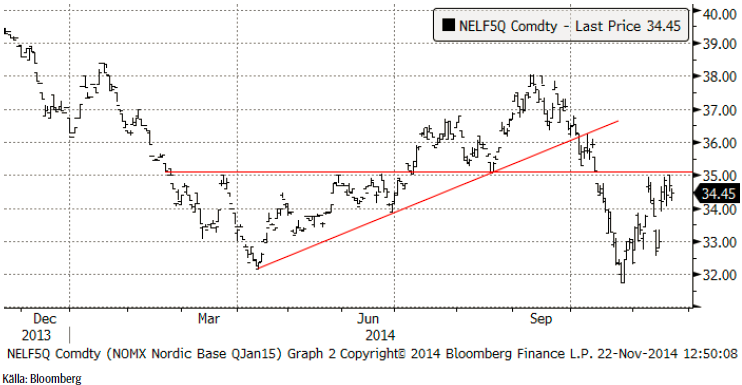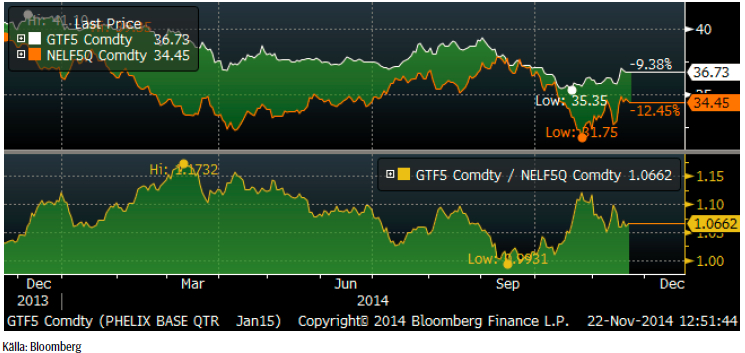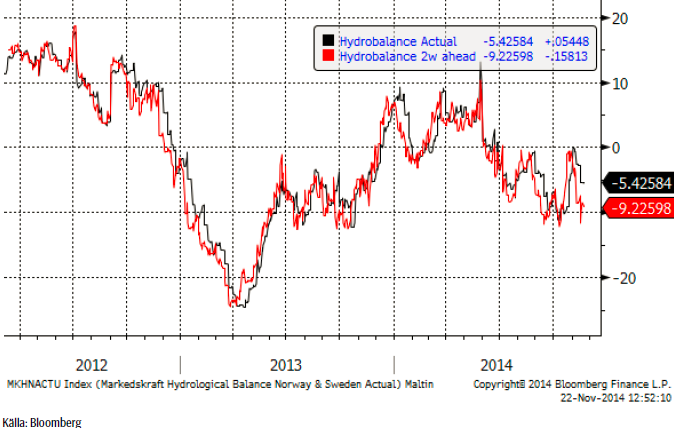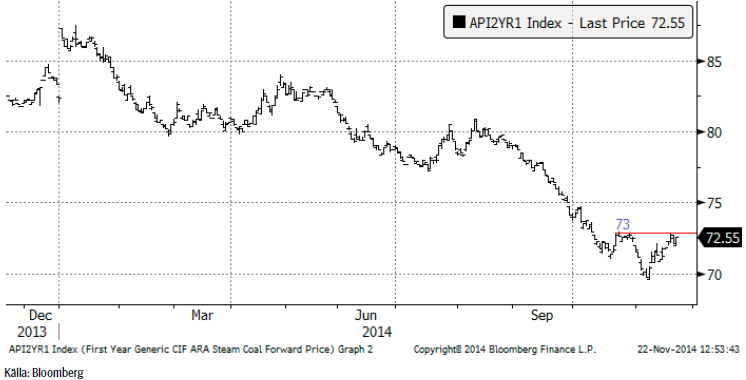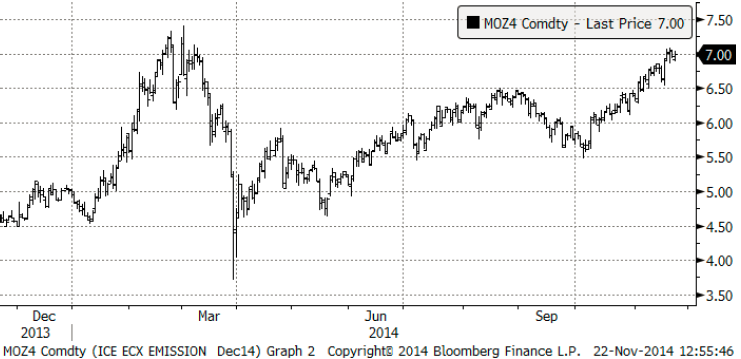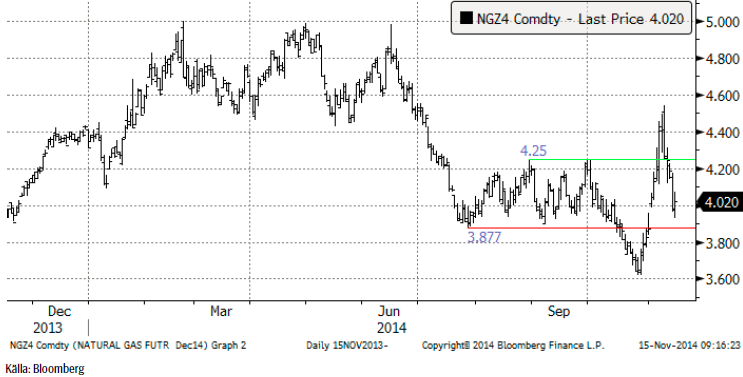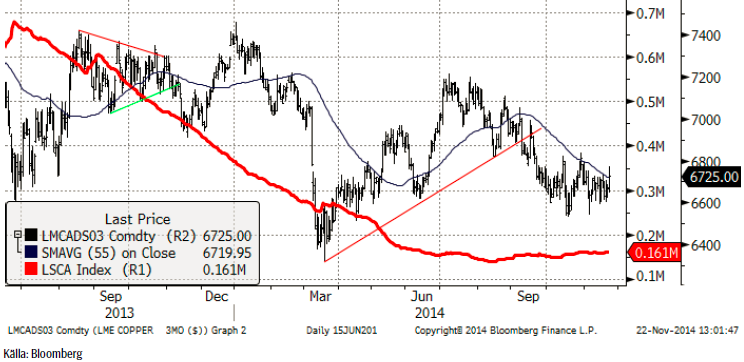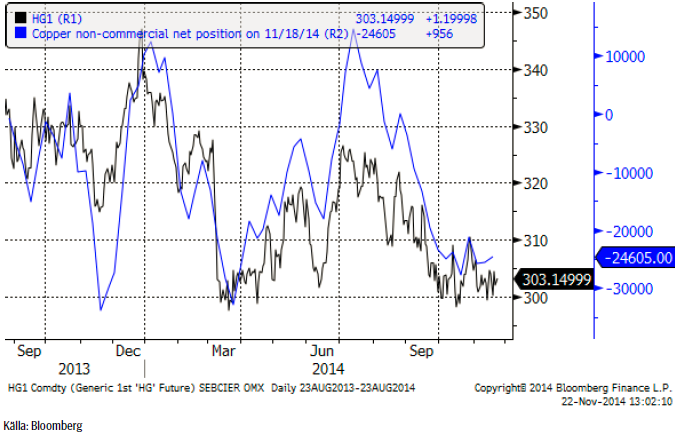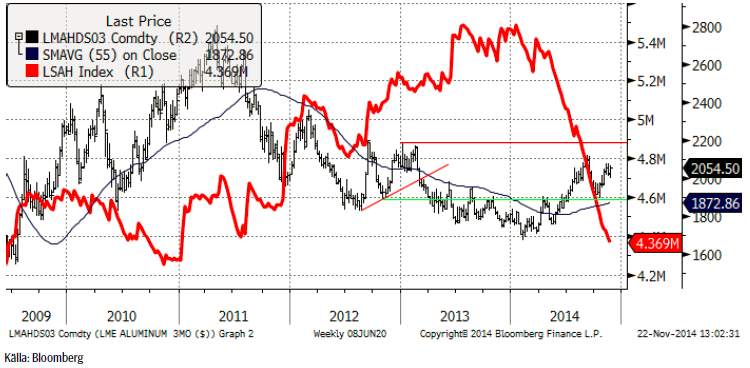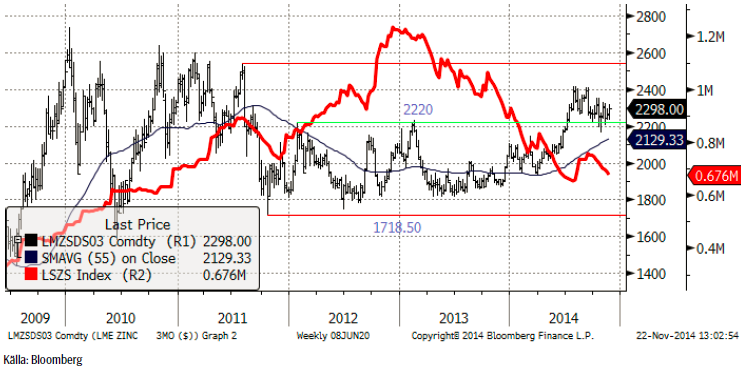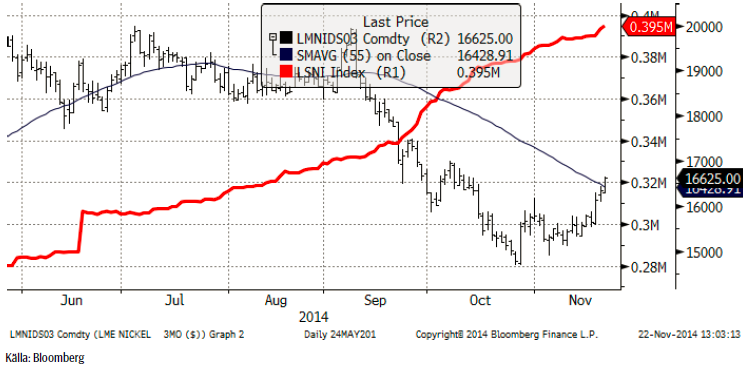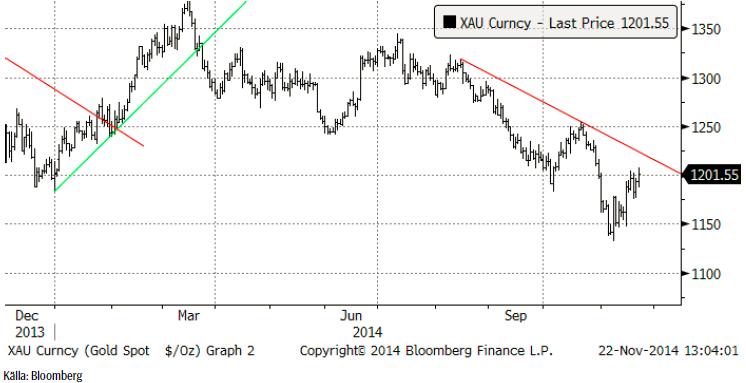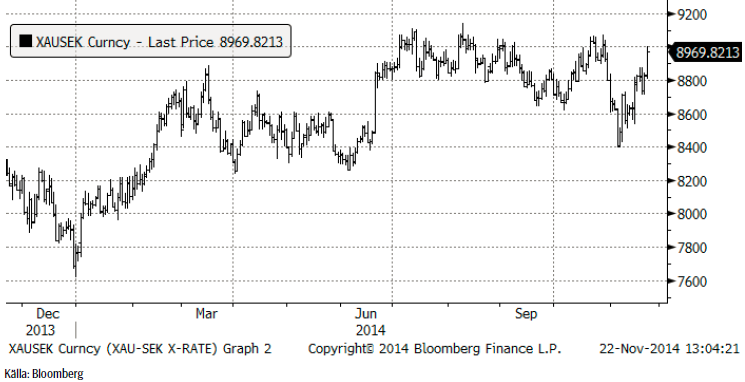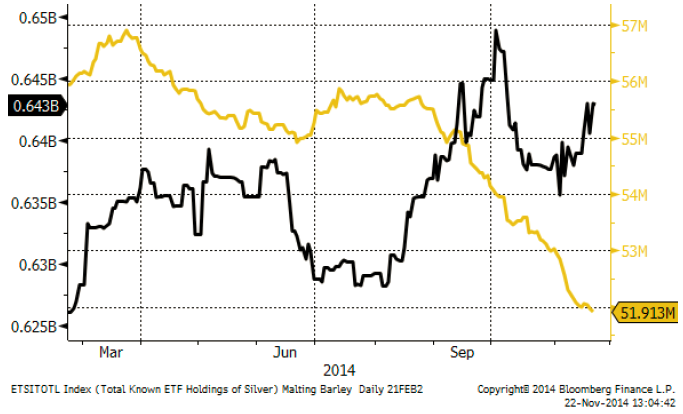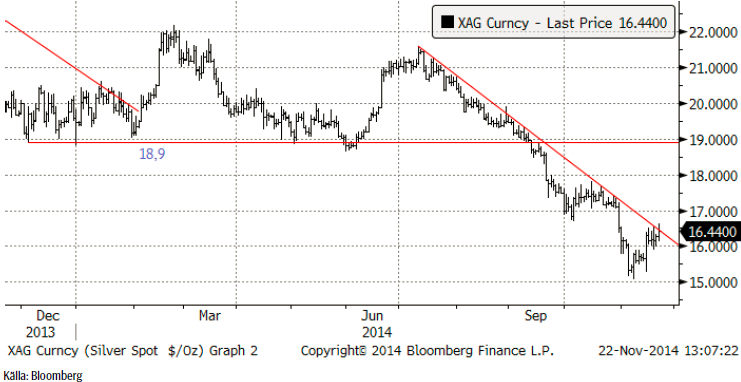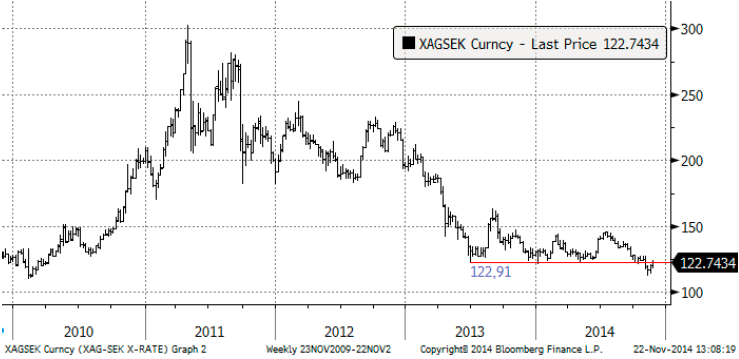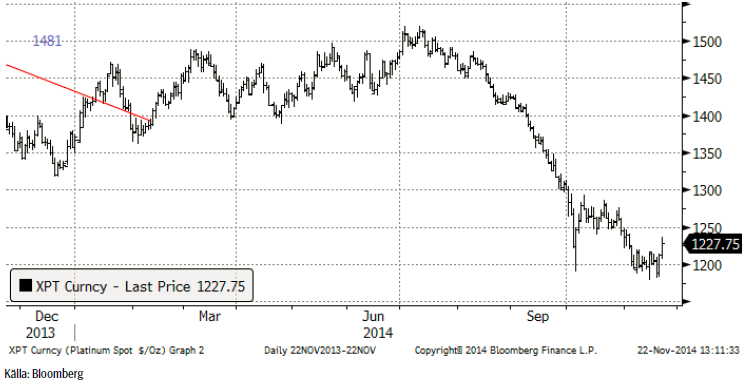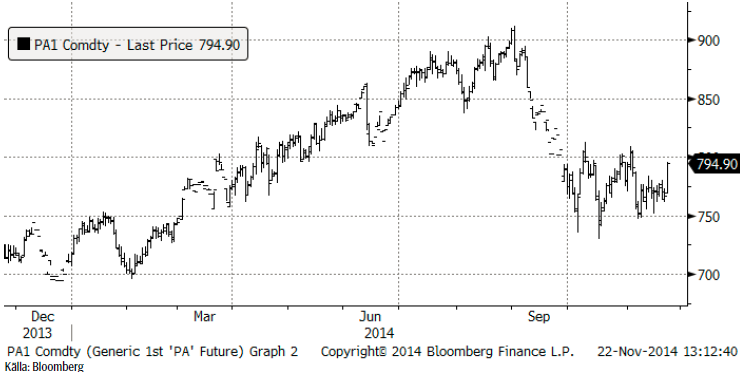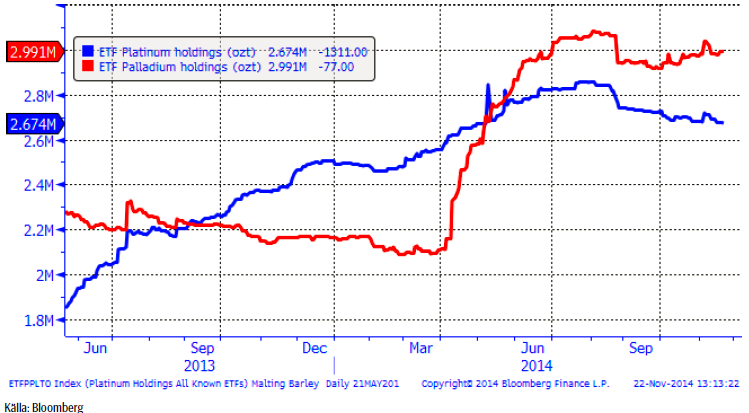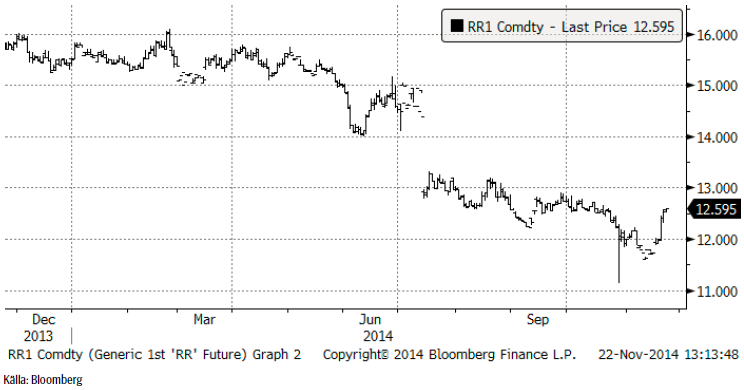Analys
SEB – Råvarukommentarer, 24 november 2014

Veckans rekommendationer
Råolja – Brent
OPEC möts i Wien på torsdag, den 27 november. Redan den 24 november (när det här brevet skickas ut), är det deadline för Irans kärnvapenförhandlingar. Iran vill ha en komplett överenskommelse och inte ett delvis lyftande av sanktionerna. Vi tror att sannolikheten för en överenskommelse till måndag är liten och det verkar marknaden tro också. Om det skulle bli en överenskommelse, skulle det leda till +1 mbpd ökat utbud det närmaste året och det vore riktigt negativt för oljepriset. Ett besked om att ingen överenskommelse nås den 24 november ger å andra sidan säkert bara lite stöd för oljepriset.
Mötet i Wien ska ses mot bakgrund av produktionen utanför OPEC och efterfrågetillväxten är sådan att ”call on OPEC” är ca 29.2 mbpd idag. OPEC skulle helst behöva se en mindre ökningstakt i produktionen av skifferolja och högre ökningstakt i efterfrågan globalt. OPEC ser idag ut att producera mer än 29.5 mbpd nästa år.
Libyen har hittills i år producerat i genomsnitt 0.45 mbpd och nästa år når de säkert 0.75 mbpd. Irak kommer att öka med 0.1 och kanske till och med 0.3 mbpd. Ett lägre oljepris dämpar ökningstakten i skifferoljeproduktion, men med eftersläpning. Nästa år ökar produktionen sannolikt med 0.1 mbpd – per månad, så att USA:s produktion ökar med 1 – 1.1 mbpd i produktionstakt.
Konsumtionen från IEA och EIA ligger också för högt. Således måste estimaten för efterfrågan justeras ner med kanske 0.3 mbpd. Med andra ord, kan ”call on OPEC” falla från 29.2 till 28.9. Det ska alltså jämföras med en produktionstakt inom OPEC på 30.3 mbpd hittills i år.
Nästa år kommer alltså att präglas av ökande lager och därmed contango i terminsmarknaden pga lagerkostnaden, starkare dollar och mindre spread mellan WTI och Brent, eventuellt.
Förväntningen på mötet i Wien den 27 november är att OPEC ska sänka produktionen. I själva verket har flera länder i OPEC behov av att öka produktionen, vilket ger ett kumulativt behov för Saudiarabien att reducera produktionen med 6 mpbp. Vi ser ett diagram över detta nedan.
Eurozonens PMI, som publicerades i torsdags kom in lägre på 51.4 jämfört med oktobers 52.1. Förväntat var en ökning till 52.3. Ett PMI över 50 anses tyda på tillväxt i ekonomin. Sedan juli har PMI kommit in lägre än förväntat, men avvikelsen har inte varit så stor på åtminstone ett år. EU:s ekonomi utvecklar sig alltså väsentligt svagare än vad analytiker i gemen förväntar sig.
Även Kinas PMI kom in lägre än förväntat på torsdagen. Väntat var 50.2 och PMI blev 50, alltså precis på gränsen mellan tillväxt i tillverkningsindustrin och tillbakagång. I fredags sänkte Kina styrräntan och det fick bland annat metallerna att flyga.
Lagren i USA ökade med 2.5 miljoner fat.
Nedan ser vi ett diagram på antalet oljeriggar i USA, enligt Baker Hughes statistik (svart). Antalet riggar i drift ökade med en från förra veckan till 1929 stycken enligt fredagskvällens statistik.
Vi rekommenderar en kort position, t ex med BEAR OLJA X2 S.
Elektricitet
Priset på första kvartalets termin har sedan förra veckan stigit från 32.99 till 34.45 euro per MWh. 35 euro är dock ett starkt tekniskt motstånd. Priset på kol och utsläpssrätter har gått upp. Hydrologisk balans har gått ner något. Väderleksprognosen (se nedan under odlingsväder) har dock slagit om till rejält blötare än normalt för Norge och Sverige. Temperaturen i Stockholm ner till Malmö väntas också bli ett par grader över det normala.
Nedan ser vi kvoten mellan priset på terminen för tysk el under första kvartalet och terminen för nordisk el för samma kvartal. Tysk el har inte fallit i pris på samma sätt under hösten som nordisk el har gjort, utan snarare gått upp något lite. Sedan september har skillnaden minskat från noll till 9.45%.
Hydrologisk balans har enligt 2-veckors prognosen fallit tillbaka ytterligare. Förra veckan prognosticerades ett underskott på 7.46 TWh och nu har underskottet ökat till -9.23 TWh.
Nedan ser vi terminskontraktet för leverans av kol under 2015, som stigit från 71.25 till 72.55 dollar per ton. Notera att det verkar finnas ett tekniskt motstånd vid 73 dollar. Bryts det, ligger nästa motstånd vid 75 dollar, men det är inte särskilt starkt. Ett lite starkare motstånd finns vid 77 dollar.
Priset på utsläppsrätter har också stigit och nådde det högsta priset sedan i mars i år.
Naturgas
Naturgaspriset har i samband med snöstormen i nordöstra USA och kylan som drabbat nästan hela landet, varit extremt volatilt. Priset vände upp från förra veckans stängningspris på 4.02 dollar till nästan samma toppnivå som för två veckor sedan, till 4.53 dollar innan priset i fredags föll kraftigt och stängde på 4.266 dollar per miljon BTU.
Efter förra veckans uppgång på 54% i BEAR NATGAS X4 S byttes denna vecka till en nedgång på 38%.
Koppar
På samma tema som förra veckan, om hypotesen att Kinas strategiska reserv, SRB, successivt köper koppar, kom i veckan en artikel i Wall Street Journal som handlade om detta. En analytiker som intervjuas i artikeln, säger att planen kan vara att köpa upp till 2 miljoner ton koppar! Enligt artikeln har köpen hittills i år uppgått till 0.5 miljoner ton. Det stämmer överens med vad du kunde läsa här förra veckan (överensstämmer med hur mycket i lagerhus utanför LME som ”försvunnit”, enligt Metal Bulletin). Metal Bulletin har samlat ihop produktionsdata för det tredje kvartalet och skriver i sin senaste rapport, att kvartalet i sin helhet kan ha haft oförändrad eller till och med lägre produktion. Anledningen skulle vara lägre halter i malmen, vilket har varit ett problem för gruvindustrin i många år. Kopparpriset visar tecken på att bottna ut. Det är lite för tidigt att säga, men vi vidhåller att priset antagligen står inför en uppgångsfas (liksom resten av basmetallerna).
Koppar är den enda metallen som handlas på en amerikansk terminsbörs och är därför den enda vi får någon information om vad spekulanterna gör. Som vi ser nedan är de fortfarande rätt sålda men 1000 kontrakt mindre än förra veckan.
Vi håller fast vid vår rekommendation av KOPPAR S.
Aluminium
Terminskurvan börjar med backwardation från december till februari och därefter i contango. Det mest iögonenfallande är dock att kurvan är nästan helt platt under större delen av nästa år. Tecknen på brist i den närmaste delen av terminskurvan är delvis en funktion av att korta positioner rullas längre fram. Inte så mycket material har levererats i samband med den tredje onsdagen i månaden och det kan vara ett tecken på att den korta sidan består av fonder, som inte har så mycket att leverera. Terminerna längre ut är däremot säkert under prispress från producenter. Icke desto mindre har marknaden stärkts i veckan som gått, särskilt i fredags. Från ett tekniskt perspektiv handlar aluminium i ett brett tradingintervall mellan 2000 och 2075 dollar med en slagsida mot uppsidan.
Vi fortsätter att rekommendera köp av ALUMINIUM S.
Zink
Som vi noterade förra veckan, ser kursutvecklingen i zink ungefär likadan ut som för koppar. Fredagens handel ser ut att ha brutit det tekniska motståndet. Styrkan i marknaden är förvånande för många aktörer. Det fundamentala underskottet i marknaden har ännu inte bitit ordentligt och investerare som köpt sig in i bull-caset har gått i och ur marknaden, vilket skapat en svängig, men trendlös marknad. Frågan är nu om marknaden håller på att diskontera allt för mycket av en ljus framtid. Tekniskt ser vi att det finns åtskilliga motstånd för en stigande trend att klara av. På kort sikt tror vi dock att zinkpriset kommer att följa med i en allmän prisuppgång på basmetaller fram till årsskiftet.
Vi rekommenderar köp av ZINK S.
Nickel
Nickelpriset steg starkt i veckan. Vi skrev förra veckan att det kunde vara dags för nickelmarknaden att vända uppåt – och det gjorde den med besked! Vi tittade på chartet och lagren och såg att priset verkade ha funnit en botten medan lagerökningen verkade ha tagit slut. Lagerökningen fortsatte faktiskt under veckan, så det var inte det som det handlade om. Icke desto mindre har antalet anullerade lagerbevis (warrants) ökat med 5000 ton mellan den 18 och 19 november. Det mesta skedde i Malaysia. Det kan vara ett tecken på en kommande vändning – och det är vad marknaden fokuserade på i veckan. Den utlösande faktorn var dock att den nya Indonesiska regeringen upprepade beslutet om exportstoppet. Vi erfar att uppgången handlar om en kombination av short-covering i terminsmarknaden och påfyllnad av lager hos industrin, som också legat ”kort” i förhållande till normal lagernivå. Tekniskt ser marknaden rätt positiv ut och indikerar högre pris på kort sikt. Brottet av triangelformationen i kombination med trendkanalsmotstånd pekar mot 17,000 dollarsnivån som mål.
Vi rekommenderar köp av NICKEL S.
Guld
ECB-chefen Mario Draghis uttalande i måndags att ECB kan komma att köpa tillgångar som guld och ETF:er på guld, för att stimulera ekonomin genom utbetalning av mer pengar, fick guldpriset att stiga.
På söndagen den 30 november går schweizarna till röstlokalerna för att bestämma om centralbanken ska köpa tillbaka 1500 ton guld som såldes i början av guldboomen på 00-talet. I den senaste opinionsmätningen var bara 38% för förslaget, så det är inte sannolikt att det går igenom. Studerar man historien, ser man att centralbanker generellt sett tenderar att sälja innan en fas av prisuppgång börjar, eller alldeles i början av den och köpa mot nära eller efter att toppen har nåtts. Ett ”ja” i den schweiziska folkomröstningen skulle snarare bekräfta den tendensen, än att vara en ”köpsignal” för oss andra. Centralbanker började köpa för några år sedan, strax innan guldpriset toppade ur och har fortsatt med det. Den senaste tiden har Ryssland köpt mest.
Fredagens prisuppgång beror till stor del på att Kina sänkte styrräntan, efter den svaga PMI-statistiken i torsdags.
Chartet för guld i kronor steg likaså.
Institutionella investerare äger via ETF/ETC-er 51.91 miljoner uns guld. Förra veckan var det 52.02 miljoner uns. Investerare har däremot ökat innehaven av silver till 643 miljoner uns från 639 miljoner uns.
Vi håller fast vid positionen i GULD S, ännu lite till.
Silver
Silverpriset håller eventuellt på att bryta den fallande pristrenden, men än är det lite för tidigt att dra den slutsatsen.
Silverpriset i kronor, nedan visat i ett veckochart, har stigit från120.53 kronor per uns förra veckan till 122.74 i fredags. Notera att motståndet vid 122.91 ännu inte är brutet. Den här uppgången är därmed mer av ett säljtillfälle. Skulle dock silver handlas i 123 eller något högre, måste man ta en stopp-loss på en position i BEAR SILVER X4 S. Tills vidare fortsätter vi dock att rekommendera köp av BEAR SILVER X4 S.
Platina & Palladium
Platina har ökat i pris från förra veckans 1213 dollar till 1227.75 vid fredagens stängning. 1250 är ett motstånd, som marknaden måste passera innan man kan börja tala om trendvändning uppåt.
Palladiumpriset har stigit från 771 förra veckan till 794.90 i fredags. Ett nytt test av motståndet som ligger strax ovanför 800 verkar troligt.
Nedanför ser vi hur mycket metall som finns i börshandlade fonder för platina respektive palladium. Investerare har sålt platina och köpt palladium den senaste veckan.
Vi fortsätter med neutral rekommendation på platina, men rekommenderar köp av palladium via t ex PALLADIUM S.
Ris
Priset på ris fortsatte att gå ner och stängde på 11.73 dollar per cwt.
För fler analyser på fler jordbruksråvaror, så som vete, majs, kaffe och kakao se SEB analysbrev om jordbruksråvaror.
[box]SEB Veckobrev Veckans råvarukommentar är producerat av SEB Merchant Banking och publiceras i samarbete och med tillstånd på Råvarumarknaden.se[/box]
Disclaimer
The information in this document has been compiled by SEB Merchant Banking, a division within Skandinaviska Enskilda Banken AB (publ) (“SEB”).
Opinions contained in this report represent the bank’s present opinion only and are subject to change without notice. All information contained in this report has been compiled in good faith from sources believed to be reliable. However, no representation or warranty, expressed or implied, is made with respect to the completeness or accuracy of its contents and the information is not to be relied upon as authoritative. Anyone considering taking actions based upon the content of this document is urged to base his or her investment decisions upon such investigations as he or she deems necessary. This document is being provided as information only, and no specific actions are being solicited as a result of it; to the extent permitted by law, no liability whatsoever is accepted for any direct or consequential loss arising from use of this document or its contents.
About SEB
SEB is a public company incorporated in Stockholm, Sweden, with limited liability. It is a participant at major Nordic and other European Regulated Markets and Multilateral Trading Facilities (as well as some non-European equivalent markets) for trading in financial instruments, such as markets operated by NASDAQ OMX, NYSE Euronext, London Stock Exchange, Deutsche Börse, Swiss Exchanges, Turquoise and Chi-X. SEB is authorized and regulated by Finansinspektionen in Sweden; it is authorized and subject to limited regulation by the Financial Services Authority for the conduct of designated investment business in the UK, and is subject to the provisions of relevant regulators in all other jurisdictions where SEB conducts operations. SEB Merchant Banking. All rights reserved.
Analys
Also OPEC+ wants to get compensation for inflation

Brent crude has fallen USD 3/b since the peak of Iran-Israel concerns last week. Still lots of talk about significant Mid-East risk premium in the current oil price. But OPEC+ is in no way anywhere close to loosing control of the oil market. Thus what will really matter is what OPEC+ decides to do in June with respect to production in Q3-24 and the market knows this very well. Saudi Arabia’s social cost-break-even is estimated at USD 100/b today. Also Saudi Arabia’s purse is hurt by 21% US inflation since Jan 2020. Saudi needs more money to make ends meet. Why shouldn’t they get a higher nominal pay as everyone else. Saudi will ask for it

Brent is down USD 3/b vs. last week as the immediate risk for Iran-Israel has faded. But risk is far from over says experts. The Brent crude oil price has fallen 3% to now USD 87.3/b since it became clear that Israel was willing to restrain itself with only a muted counter attack versus Israel while Iran at the same time totally played down the counterattack by Israel. The hope now is of course that that was the end of it. The real fear has now receded for the scenario where Israeli and Iranian exchanges of rockets and drones would escalate to a point where also the US is dragged into it with Mid East oil supply being hurt in the end. Not everyone are as optimistic. Professor Meir Javedanfar who teaches Iranian-Israeli studies in Israel instead judges that ”this is just the beginning” and that they sooner or later will confront each other again according to NYT. While the the tension between Iran and Israel has faded significantly, the pain and anger spiraling out of destruction of Gaza will however close to guarantee that bombs and military strifes will take place left, right and center in the Middle East going forward.
Also OPEC+ wants to get paid. At the start of 2020 the 20 year inflation adjusted average Brent crude price stood at USD 76.6/b. If we keep the averaging period fixed and move forward till today that inflation adjusted average has risen to USD 92.5/b. So when OPEC looks in its purse and income stream it today needs a 21% higher oil price than in January 2020 in order to make ends meet and OPEC(+) is working hard to get it.
Much talk about Mid-East risk premium of USD 5-10-25/b. But OPEC+ is in control so why does it matter. There is much talk these days that there is a significant risk premium in Brent crude these days and that it could evaporate if the erratic state of the Middle East as well as Ukraine/Russia settles down. With the latest gains in US oil inventories one could maybe argue that there is a USD 5/b risk premium versus total US commercial crude and product inventories in the Brent crude oil price today. But what really matters for the oil price is what OPEC+ decides to do in June with respect to Q3-24 production. We are in no doubt that the group will steer this market to where they want it also in Q3-24. If there is a little bit too much oil in the market versus demand then they will trim supply accordingly.
Also OPEC+ wants to make ends meet. The 20-year real average Brent price from 2000 to 2019 stood at USD 76.6/b in Jan 2020. That same averaging period is today at USD 92.5/b in today’s money value. OPEC+ needs a higher nominal price to make ends meet and they will work hard to get it.
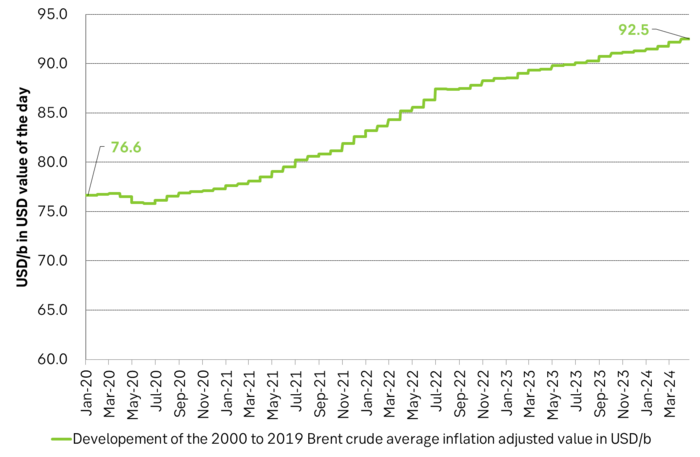
Inflation adjusted Brent crude price versus total US commercial crude and product stocks. A bit above the regression line. Maybe USD 5/b risk premium. But type of inventories matter. Latest big gains were in Propane and Other oils and not so much in crude and products

Total US commercial crude and product stocks usually rise by 4-5 m b per week this time of year. Gains have been very strong lately, but mostly in Propane and Other oils

Last week’s US inventory data. Big rise of 10 m b in commercial inventories. What really stands out is the big gains in Propane and Other oils
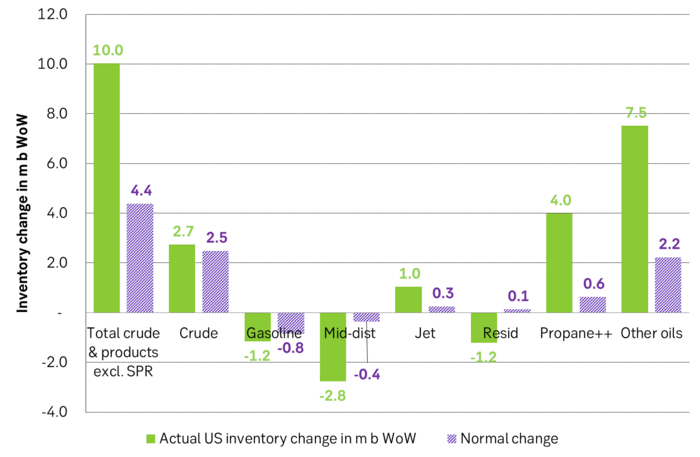
Take actual changes minus normal seasonal changes we find that US commercial crude and regular products like diesel, gasoline, jet and bunker oil actually fell 3 m b versus normal change.

Analys
Nat gas to EUA correlation will likely switch to negative in 2026/27 onward

Historically positive Nat gas to EUA correlation will likely switch to negative in 2026/27 onward

Historically there has been a strong, positive correlation between EUAs and nat gas prices. That correlation is still fully intact and possibly even stronger than ever as traders increasingly takes this correlation as a given with possible amplification through trading action.
The correlation broke down in 2022 as nat gas prices went ballistic but overall the relationship has been very strong for quite a few years.
The correlation between nat gas and EUAs should be positive as long as there is a dynamical mix of coal and gas in EU power sector and the EUA market is neither too tight nor too weak:
Nat gas price UP => ”you go black” by using more coal => higher emissions => EUA price UP
But in the future we’ll go beyond the dynamically capacity to flex between nat gas and coal. As the EUA price moves yet higher along with a tightening carbon market the dynamical coal to gas flex will max out. The EUA price will then trade significantly above where this flex technically will occur. There will still be quite a few coal fired power plants running since they are needed for grid stability and supply amid constrained local grids.
As it looks now we still have such overall coal to gas flex in 2024 and partially in 2025, but come 2026 it could be all maxed out. At least if we look at implied pricing on the forward curves where the forward EUA price for 2026 and 2027 are trading way above technical coal to gas differentials. The current forward pricing implications matches well with what we theoretically expect to see as the EUA market gets tighter and marginal abatement moves from the power sector to the industrial sector. The EUA price should then trade up and way above the technical coal to gas differentials. That is also what we see in current forward prices for 2026 and 2027.
The correlation between nat gas and EUAs should then (2026/27 onward) switch from positive to negative. What is left of coal in the power mix will then no longer be dynamically involved versus nat gas and EUAs. The overall power price will then be ruled by EUA prices, nat gas prices and renewable penetration. There will be pockets with high cost power in the geographical points where there are no other alternatives than coal.
The EUA price is an added cost of energy as long as we consume fossil energy. Thus both today and in future years we’ll have the following as long as we consume fossil energy:
EUA price UP => Pain for consumers of energy => lower energy consumption, faster implementation of energy efficiency and renewable energy => lower emissions
The whole idea with the EUA price is after all that emissions goes down when the EUA price goes up. Either due to reduced energy consumption directly, accelerated energy efficiency measures or faster switch to renewable energy etc.
Let’s say that the coal to gas flex is maxed out with an EUA price way above the technical coal to gas differentials in 2026/27 and later. If the nat gas price then goes up it will no longer be an option to ”go black” and use more coal as the distance to that is too far away price vise due to a tight carbon market and a high EUA price. We’ll then instead have that:
Nat gas higher => higher energy costs with pain for consumers => weaker nat gas / energy demand & stronger drive for energy efficiency implementation & stronger drive for more non-fossil energy => lower emissions => EUA price lower
And if nat gas prices goes down it will give an incentive to consume more nat gas and thus emit more CO2:
Cheaper nat gas => Cheaper energy costs altogether, higher energy and nat gas consumption, less energy efficiency implementations in the broader economy => emissions either goes up or falls slower than before => EUA price UP
Historical and current positive correlation between nat gas and EUA prices should thus not at all be taken for granted for ever and we do expect this correlation to switch to negative some time in 2026/27.
In the UK there is hardly any coal left at all in the power mix. There is thus no option to ”go black” and burn more coal if the nat gas price goes up. A higher nat gas price will instead inflict pain on consumers of energy and lead to lower energy consumption, lower nat gas consumption and lower emissions on the margin. There is still some positive correlation left between nat gas and UKAs but it is very weak and it could relate to correlations between power prices in the UK and the continent as well as some correlations between UKAs and EUAs.
Correlation of daily changes in front month EUA prices and front-year TTF nat gas prices, 250dma correlation.
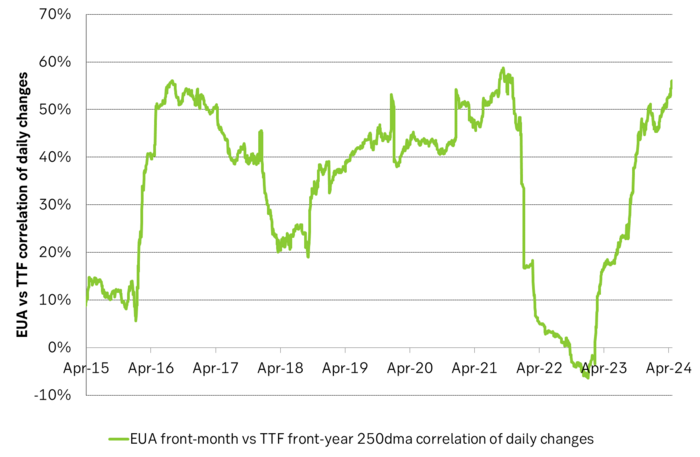
EUA price vs front-year TTF nat gas price since March 2023
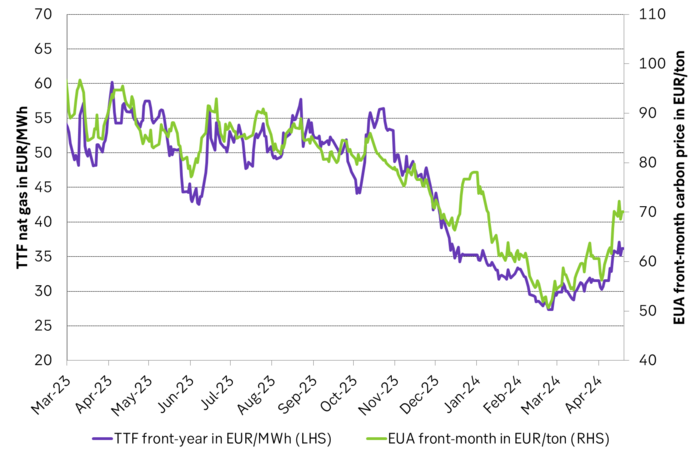
Front-month EUA price vs regression function of EUA price vs. nat gas derived from data from Apr to Nov last year.
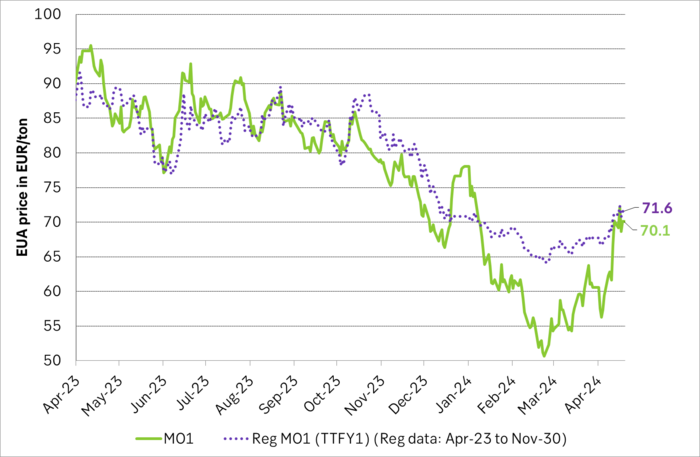
The EUA price vs the UKA price. Correlations previously, but not much any more.
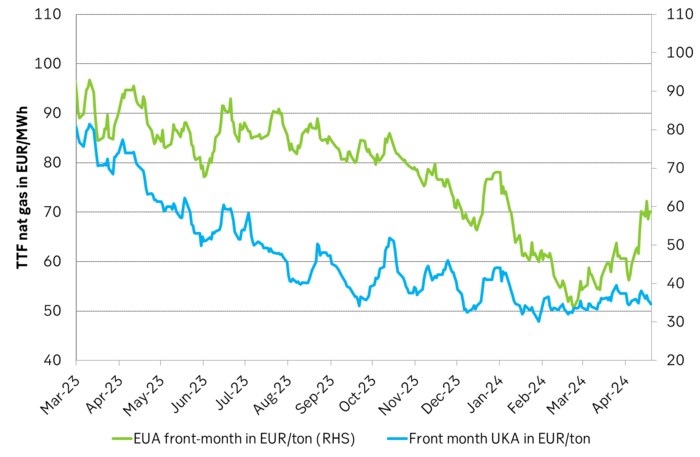
Forward German power prices versus clean cost of coal and clean cost of gas power. Coal is totally priced out vs power and nat gas on a forward 2026/27 basis.

Forward price of EUAs versus technical level where dynamical coal to gas flex typically takes place. EUA price for 2026/27 is at a level where there is no longer any price dynamical interaction or flex between coal and nat gas. The EUA price should/could then start to be negatively correlated to nat gas.

Forward EAU price vs. BNEF base model run (look for new update will come in late April), SEB’s EUA price forecast.
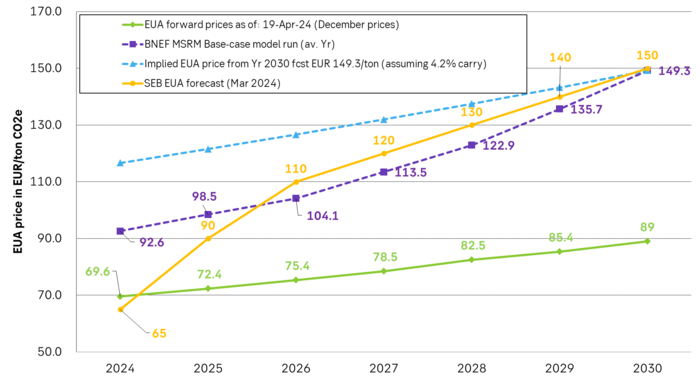
Analys
Fear that retaliations will escalate but hopes that they are fading in magnitude

Brent crude spikes to USD 90.75/b before falling back as Iran plays it down. Brent crude fell sharply on Wednesday following fairly bearish US oil inventory data and yesterday it fell all the way to USD 86.09/b before a close of USD 87.11/b. Quite close to where Brent traded before the 1 April attack. This morning Brent spiked back up to USD 90.75/b (+4%) on news of Israeli retaliatory attack on Iran. Since then it has quickly fallen back to USD 88.2/b, up only 1.3% vs. ydy close.

The fear is that we are on an escalating tit-for-tat retaliatory path. Following explosions in Iran this morning the immediate fear was that we now are on a tit-for-tat escalating retaliatory path which in the could end up in an uncontrollable war where the US unwillingly is pulled into an armed conflict with Iran. Iran has however largely diffused this fear as it has played down the whole thing thus signalling that the risk for yet another leg higher in retaliatory strikes from Iran towards Israel appears low.
The hope is that the retaliatory strikes will be fading in magnitude and then fizzle out. What we can hope for is that the current tit-for-tat retaliatory strikes are fading in magnitude rather than rising in magnitude. Yes, Iran may retaliate to what Israel did this morning, but the hope if it does is that it is of fading magnitude rather than escalating magnitude.
Israel is playing with ”US house money”. What is very clear is that neither the US nor Iran want to end up in an armed conflict with each other. The US concern is that it involuntary is dragged backwards into such a conflict if Israel cannot control itself. As one US official put it: ”Israel is playing with (US) house money”. One can only imagine how US diplomatic phone lines currently are running red-hot with frenetic diplomatic efforts to try to defuse the situation.
It will likely go well as neither the US nor Iran wants to end up in a military conflict with each other. The underlying position is that both the US and Iran seems to detest the though of getting involved in a direct military conflict with each other and that the US is doing its utmost to hold back Israel. This is probably going a long way to convince the market that this situation is not going to fully blow up.
The oil market is nonetheless concerned as there is too much oil supply at stake. The oil market is however still naturally concerned and uncomfortable about the whole situation as there is so much oil supply at stake if the situation actually did blow up. Reports of traders buying far out of the money call options is a witness of that.
-

 Nyheter3 veckor sedan
Nyheter3 veckor sedanGuldpriset når nytt all time high och bryter igenom 2300 USD
-

 Nyheter4 veckor sedan
Nyheter4 veckor sedanLundin Mining får köprekommendation av BMO
-

 Nyheter3 veckor sedan
Nyheter3 veckor sedanCentralbanker fortsatte att köpa guld under februari
-

 Nyheter2 veckor sedan
Nyheter2 veckor sedanUSAs stigande konsumtion av naturgas
-

 Nyheter3 veckor sedan
Nyheter3 veckor sedanKakaomarknaden är extrem för tillfället
-

 Nyheter3 veckor sedan
Nyheter3 veckor sedanHur mår den svenska skogsbraschen? Två favoritaktier
-

 Nyheter4 veckor sedan
Nyheter4 veckor sedanBoliden på 20 minuter
-

 Nyheter3 veckor sedan
Nyheter3 veckor sedanBetydande underskott i utbudet av olja kan få priset att blossa upp


